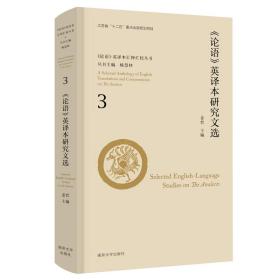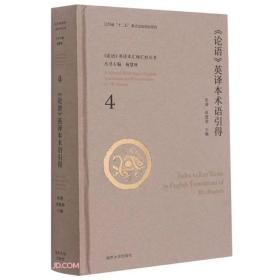
《论语》及其英译本的投射语言对等研究9787306068217
正版图书,可开发票,请放心购买。
¥ 28 8.0折 ¥ 35 全新
库存2件
广东广州
认证卖家担保交易快速发货售后保障
作者胡红辉著
出版社中山大学出版社
ISBN9787306068217
出版时间2019-12
装帧平装
开本32开
定价35元
货号9789023
上书时间2024-12-12
- 店主推荐
- 最新上架
商品详情
- 品相描述:全新
- 商品描述
-
作者简介
胡红辉,广东财经大学副教授,2016年获中山大学文学博士学位。主要研究兴趣包括:功能语言学、外语教学。
目录
List of Figures
List of Tables
List of Abbreviations
Chapter 1 Introduction
1.1 Preamble
1.2 Motivation for the study
1.3 Research objectives and research questions
1.4 Research methodology
1.5 Data collection
1.6 Organization of the book
Chapter 2 Literature Review
2.1 Introduction
2.2 Previous studies on projection
2.2.1 Stylistic approaches to projection
2.2.2 Linguistic approaches to projection
2.3 Previous studies on translation in SFL
2.3.1 Catfords studies of "equivalence" and "shift" in translation
2.3.2 Houses model of translation quality assessment
2.3.3 Bells descriptive study of translation
2.3.4 Bakers analysis of thematic structures in translation
2.3.5 Hallidays views on translation
2.4 Previous studies on the Lunyu and its translation
2.4.1 Studies on the Lunyu and its translation in various disciplines
2.4.2 Studies on the Lunyu and its translation in SFL
2.5 Summary
Chapter 3 Theoretical Framework
3.1 Introduction
3.2 SFL as the theoretical framework of the present study
3.3 The linguistic parameters defining equivalence
3.3.1 Instantiation
3.3.2 Stratification
3.3.3 Metafunction
3.3.4 Axis
3.4 Translation as recreation of meaning through choice
3.5 The study of equivalence in context
3.5.1 The context-metafunction hook-up
3.5.2 Register
3.5.3 Equivalence study based on FDA
3.6 The framework of analysis in the present study
3.7 Summary
Chapter 4 Different Types and Structures of Projection in the Lunyu and Its Translations
4.1 Introduction
4.2 Different realizations of projection in the ST
4.3 Clarifying the data of analysis in the ST
4.4 Differem types of projection in the TTs
4.4.1 Types of projection in the part of aphorism
4.4.2 Types of projection in the part of dialogues
4.4.3 Types of projection in the asking turn of brief dialogues
4.5 Different structures of projection in the TTs
4.6 Summary
Chapter 5 Ideational Equivalence of Projection in the Lunyu and Its Translations
5.1 Introduction
5.2 Ideational metafunction in projection
5.2.1 Experiential metafunction in projection
5.2.2 Logical metafunction in projection
5.3 Degrees of ideational equivalence in projection
5.4 Reasons for the different realizations of projection
5.4.1 Different interpretations of the ST
5.4.2 Translators meaningful choices
5.5 Summary
Chapter 6 Interpersonal Equivalence of Projection in the Lunyu and Its Translations
6.1 Introduction
6.2 Speech functions realized in projection
6.2.1 Equivalence of speech functions realized in projection
6.2.2 Shifts of speech functions realized in projection
6.3 Mood elements in the projecting clause
6.3.1 Equivalence in Mood in the projecting clause
6.3.2 Shifts in the Mood elements of the projecting clause
6.4 Modality in the projected clauses
6.4.1 Modality realizing different speech functions in projection
6.4.2 Modality realizing different values in the projected clause
6.4.3 Understanding of modality in the ST resulting in different choices in the TTs
6.5 Person system in projection
6.6 Summary
Chapter 7 Textual Equivalence of Projection in the Lunyu
and Its Translations
7.1 Introduction
7.2 System of Theme in the projection clause nexus
7.3 Thematic structure in projection
7.3.1 Thematic structures of projection in the aphorisms
7.3.2 Thematic structures of projection in the dialogues
7.3.3 Textual meaning realized in the thematic structures
7.4 Thematic-progression patterns in projection
7.4.1 Patterns of thematic progression in the aphorisms
7.4.2 Patterns of thematic progression in the part of dialogues
7.4.3 Textual meanings realized by patterns of thematic progression
7.5 Study of cohesion in projection
7.5.1 Cohesion in the aphorisms
7.5.2 Cohesion in the part of dialogues
7.5.3 Textual meaning realized in the cohesive methods
7.6 Summary
Chapter 8 Equivalence of Projection in the Lunyu and Its Translations in Context
8.1 Introduction
8.2 Equivalence in context
8.3 Register analysis for the ST and TTs
8.3.1 Register analysis of the ST
8.3.2 Register analysis of the TTs
8.4 Equivalence study of projection in the context
8.4.1 Equivalence study of projection in the context of situation
8.4.2 Evaluation of different TTs in the context of culture
8.5 Summary
Chapter 9 Discussion
9.1 Introduction
9.2 Observation and description of projection choices
9.3 The value of a metafunctional analysis of projection
9.3.1 Value of the ideational analysis of projection
9.3.2 Value of the interpersonal analysis of projection
9.3.3 Value of textual analysis in projection
9.4 Evaluation of translation quality in the comext
9.4.1 Purpose of the translators
9.4.2 Literal translation and free translation
9.4.3 Role of translators
9.5 Summary
Chapter 10 Conclusion
10.1 Introduction
10.2 An overview of the study
10.3 Main research findings
10.4 Implications of the research
10.5 Limitations and suggestions for further studies
References
Appendix I The courtesy names and given names of Confucius main disciples
Appendix II Translations of the examples given in Chapter 4
内容摘要
本书基于系统功能语言学理论,从词汇语法层面、语义功能层面及语境层面对《论语》原文及英译本中投射语言的对等问题进行了系统描述和分析,分别探讨了《论语》不同译文投射语言在概念功能、人际功能及语篇功能三方面所实现的不同程度相对对等,并在文化语境下对投射语言所实现的对等程度进行分析与评估,试图构建一个相关语篇的投射语言英译对等程度研究范式。研究表明,语录体文本中投射语言的翻译对等研究,可以体现整个文本原文及译文之间的对等程度,并反映出不同译本的翻译特色。本书适合英语专业本科生、研宄生以及对功能语言学与翻译研究及语录体文本研宄感兴趣的所有研究者使用。
精彩内容
本书基于系统功能语言学理论,从词汇语法层面、语义功能层面及语境层面对《论语》原文及英译本中投射语言的对等问题进行了系统描述和分析,分别探讨了《论语》不同译文投射语言在概念功能、人际功能及语篇功能三方面所实现的不同程度相对对等,并在文化语境下对投射语言所实现的对等程度进行分析与评估,试图构建一个相关语篇的投射语言英译对等程度研究范式。研究表明,语录体文本中投射语言的翻译对等研究,可以体现整个文本原文及译文之间的对等程度,并反映出不同译本的翻译特色。本书适合英语专业本科生、研宄生以及对功能语言学与翻译研究及语录体文本研宄感兴趣的所有研究者使用。
相关推荐
— 没有更多了 —






























以下为对购买帮助不大的评价